
Joshua Johnston (or Johnson) (1765 - 1830) "Portrait of a Gentleman" Oil on canvas 1805 Listed in 1796 and 1824 as a Joshua Johnston, "free householder of colour, portrait painter." He also painted children. From: Coker, Gylbert. "Nineteenth - Century African American Art," The Harmon and Harriet Kelley Collection of African American Art. The University of Texas Press: Texas, 1994, 46. Note: Harmon and Harriet Kelley have demanded that we not show images of any paintings they own. Instead, See 5 paintings displayed by the National
Gallery of Art. |
Joshua Johnston (or Johnson) (1765 - 1830) "The Westwood Children" Oil on canvas 1807 Johnson was one of the earliest African American visual artists to receive professional recognition. His career began in 1789 and was greeted with acclaim between 1796 and 1824. Characteristics of his art are sitters sitting at a three quarter's view, Sheraton chairs, elliptical eyes, elaborate collars, skirt fabrics and suits. From: Britton, Crystal A.. African American Art -- The Long Struggle. Todtri Productions Limited: New York, New York. 1996, 23. other
paintings |
Edmonia Wildfire Lewis ( 1845 - 1900? ) "Death of Cleopatra" 1876 This work was exhibited in the Women's Pavilion at the Centennial Exposition in Philadelphia in 1876 with 600 other sculptures by various other artists, and caused a sensation due to the realistic portrayal of Cleopatra. The statue shows female power and vulnerability (power in the fact that Cleopatra was a femme fatale, and vulnerability in the fact that she is dead.) Lewis may be making reference to how Cleopatra was thwarted in her attempts for power, but in suicide she has control. Lewis was quoted by William Wells Brown in "The Rising Son" (1874): "I have a strong sympathy for all women who have struggled and suffered" (97). From: Patton, Sharon F. Oxford History of Art - African-American Art. Oxford University Press: New York, 1998, 96. |
Edmonia Wildfire Lewis ( 1845 - 1900? ) "Forever Free" Marble 1867 A third-generation African-American, Lewis was born with the name Wildfire, but changed it to Edmonia. She was the first African American woman to have an international career in the fine arts. Persecuted in art school and not allowed to graduate, she worked with abolitionists and opened a studio in Rome in 1865 from the money earned by a bust of Colonel Robert Gould Shaw. The sculpture is modelled on an engraving, "Am I Not a Man and a Brother," used in Abolitionist publications. From: Britton, Crystal A.. African American Art - The Long Struggle. Todtri Productions Limited: New York, New York. 1996, 31. Other works |
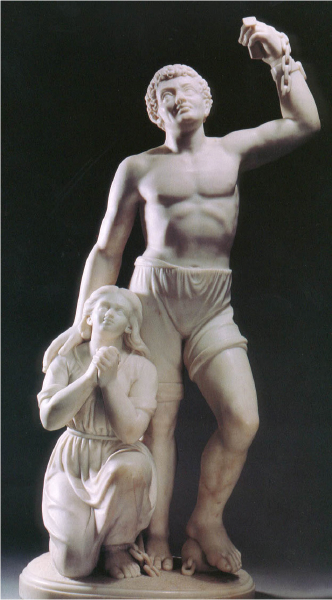 |
Grafton Taylor Brown (1841 - 1918) "Yosemite Falls" Oil on canvas 1888 The flatness and static nature of this painting likely derives from Brown's lithographic style. From: Guy C. McElroy et al.. African - American Artists : 1880 - 1987. University of Washington Press : Seattle, Washington, 1989, 19. A biography and photo portrait is available at the Schomburg Center for Research in Black Culture |
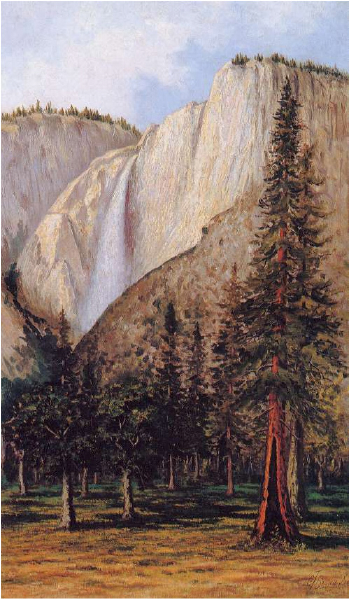 |
Harriet Powers ( 1837 - 1911 ) "Bible Quilt" 1886 The quilt has faded considerably - the light tan was once deep pink and the yellowish brown borders were once green. Panels in quilt show spiritual stories, and were a way for the illiterate Powers to preserve her memories. Among the scenes depicted are Noah and the art, and Jacob and the ladder. From: Patton, Sharon F. Oxford History of Art - African-American Art. Oxford University Press: New York, 1998, 69. |
Henry Ossawa Tanner (1859 - 1937 ) "The Banjo Lesson" Oil on canvas 1893 Tanner moved to France to escape racism. He spoke on "The American Negro in Art" at World's Columbian exposition in Chicago, and "claimed that actual achievement proved Negroes possess ability and talent for successful competition with white artists" (8). This speech influenced his art, and he started a series of genre paintings to combat stereotypes. This is one image from that series. From: Britton, Crystal A.. African American Art - The Long Struggle. Todtri Productions Limited: New York, New York. 1996, 33. Other paintings Photos of Tanner from Smithsonian
|
Harriet Powers (1837 - 1911) "Bible Quilt" 1898 The images in this quilt are from local parables and stories. Panel 8 (dark blue with yellow stars): "The falling of stars on November 13, 1833. The people were frightened and thought the end of time had come. God's hand staid the stars. The varmints rushed out of their beds." (70) From: Patton, Sharon F. Oxford History of Art - African-American Art. Oxford University Press: New York, 1998, 70. |
William A. Harper ( 1873 - 1910 ) "Landscape with Poplars (Afternoon at Montigny)" Oil on canvas 1898 Acclaimed as a rising talent, Harper died at only 37. He was influenced by the Barbizon school of naturalist painters who focused on atmosphere and attention to detail. From: Britton, Crystal A.. African American Art - The Long Struggle. Todtri Productions Limited: New York, New York. 1996, 18. |
Henry Ossawa Tanner (1859 - 1937 ) "Head of a Girl in Jerusalem (The Artist's Wife)" Oil on artist board 1899 From : Coker, Gylbert. "Nineteenth - Century African American Art." The Harmon and Harriet Kelley Collection of African American Art. The University of Texas Press : Texas, 1994, 24. |
Nelson Primus (1843 - 1916? ) "Portrait of a Lady (Lady with Golden Hair)" Oil on canvas 1907 His success was more limited than that of Bannister, and much of his work is lost. From : Guy C. McElroy et al.. African - American Artists : 1880 - 1987. University of Washington Press : Seattle, Washington, 1989, 21. |
Henry Ossawa Tanner (1859 - 1937) "The Visitor" Pastel on paper 1910 He moved to France to escape racism. He spoke on "The American Negro in Art" at World's Columbian exposition in Chicago, and "claimed that actual achievement proved negroes possess ability and talent for successful competition with white artists" (8). This speech impacted his art, and he started a series of genre paintings to combat stereotypes. From: Coker, Gylbert. "Nineteenth - Century African American Art." The Harmon and Harriet Kelley Collection of African American Art. The University of Texas Press : Texas, 1994, 9. |
Other Tanner paintings on the Web |
Edwin A. Harleston ( 1882 – 1931 ), "Portrait of a Woman" 1920 Harleston was known for sensitive realistic portraits of African Americans, especially of the working class. He received many awards, including an Amy Spingarn prize in 1924 for his portrait of his wife. From : Barnwell, Andrea D. The Walter O. Evans Collection of African American Art. University of Washington Press : Seattle, Washington, 1999, 103. |
Nancy Elizabeth Prophet (1890 - 1960), "Silence," Marble 1920-1930 An early female artist, Prophet graduated from the Rhode Island School of Design and studied in Paris. Like many other African-American artists, musicians and writers of the period, she stayed in France for ten years, then returned to U.S. in 1934 and started a sculpture program at Spelman College in Atlanta, Georgia. Her subjects are almost always African American, and "embody a spirit of quiet pride and self respect." From: Britton, Crystal A.. African American Art - The Long Struggle. Todtri Productions Limited : New York, New York. 1996, 29. |
See also: |
Archibald J. Motley Jr. ( 1891 - 1981 ), "Mending Socks" 1924 This is the artist's paternal grandmother, Emily Motley. This image and "The Octoroon Girl," according to the artist, are among his favorites. The portrait is a variation/parody of Whistler's portrait of his mother. From: Patton, Sharon F. Oxford History of Art - African-American Art. Oxford University Press: New York, 1998, 121. |
Archibald J. Motley Jr. ( 1891 - 1981 ), "The Octoroon Girl" 1925 This image and "Mending Socks," according to the artist,
are among his best. "The Octoroon Girl" is one of several "scientific" paintings
examining light-skinned African- From: Patton, Sharon F. Oxford History of Art - African-American Art. Oxford University Press: New York, 1998, 122. Other paintings |
Palmer Hayden (1893 - 1973) "Fétiche et Fleurs" (Fetish and Flowers), 1926 Fang reliquary sculpture and Kuba cloth were popular representations of African art in the USA and Paris. This image won the Harmon Foundation's Gold Medal for distinguished Achievement Among Negroes in Fine Arts in 1926. The painting strives to find a new racial art medium, and to adapt the genre of still life to Africana themes. From: Patton, Sharon F. Oxford History of Art - African-American Art. Oxford University Press: New York, 1998, 120. |
See Also: |
James Van DerZee (1886 - 1983 "Alpha Phi Alpha Basketball Team," Photograph 1926Van DerZee chronicled Harlem between 1920 and 1940. He edited his photos to best show his sitters. From: Guy C. McElroy et al.. African - American Artists : 1880 - 1987. University of Washington Press : Seattle, Washington, 1989, 44. |
Vivian Schuyler Key ( 1905 - 1990) Cover illustration for "The Crisis, A Record of the Darker Races," Watercolor wash February 1929 Key could not find work after graduating from the Pratt Institute in 1926 as a fine artist, so she went into painting fabrics and giftware. She also designed covers for Crisis. From: Britton, Crystal A.. African American Art - The Long Struggle. Todtri Productions Limited : New York, New York. 1996, 47. Current online issue of The Crisis |
permission pending |
Aaron Douglas (1899 - 1979), "Aspects of Negro Life: Song of the Towers" 1934 Douglas was an artist of the "Negro Renaissance Period." He used Art Deco styles learned from Winold Reiss. He was also a socialist and had labor union sympathies. He was a member of the Harlem Artists Guild, the African American artist's alternative to the Artist's Union. From: Patton, Sharon F. Oxford History of Art - African-American Art. Oxford University Press : New York, 1998, 142. Other works
|
Charles Alston (1907 - 1977), "The Blue Shirt," Oil on Canvas 1935 Alston was the director of the Harlem Art Workshop in 1932, and the director of the WPA Harlem Mural project, which made the first public positive representation of African Americans in two murals at Harlem Hospital in 1937. From: Coker, Gylbert. "Nineteenth - Century African American Art" The Harmon and Harriet Kelley Collection of African American Art. The University of Texas Press : Texas, 1994, 21. |
Hale A. Woodruff ( 1900 - 1980 ), "Landscape" Oil on canvas 1936 In the 1930s and 1940s American landscape and common folk were believed to be proper subjects for authentic American art. In 1936, Woodruff (who had studied the post-impressionists and Mexican muralists) embraced an art devoted almost completely to black share croppers, vernacular architecture, and Georgia landscapes (such as the one above.) From: Guy C. McElroy et al.. African - American Artists : 1880 - 1987. University of Washington Press: Seattle, Washington, 1989, 65. Returning
Home (Howard University) |
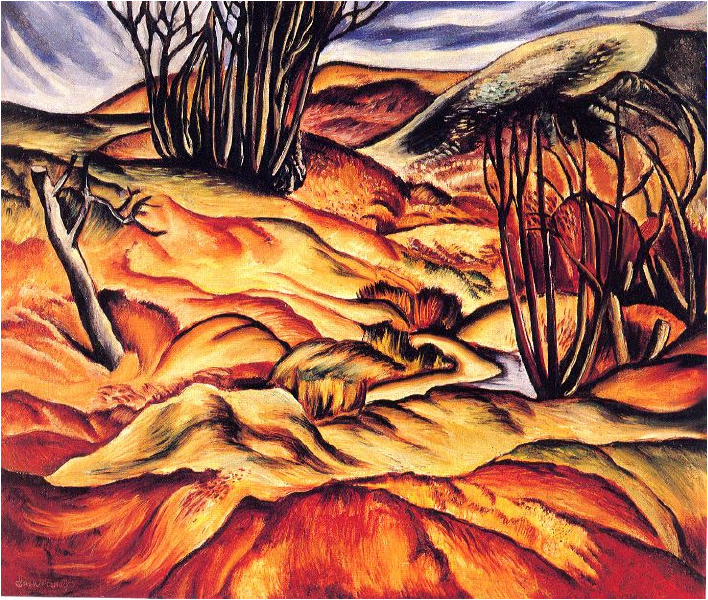 |
Aaron Douglas ( 1899 - 1979 ), "Aspiration" Oil on canvas 1936 From: Guy C. McElroy et al.. African - American Artists : 1880 - 1987. University of Washington Press: Seattle, Washington, 1989, 52. |
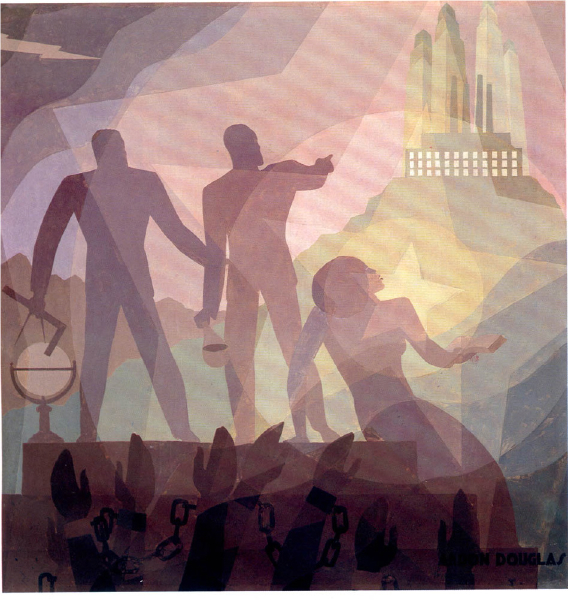 |
Norman Lewis ( 1909 - 1979 ), "Yellow Hat" 1936 Lewis painted early in his career. He organized groups to help other African American artists with stylistic ideas. From: Patton, Sharon F. Oxford History of Art - African-American Art. Oxford University Press : New York, 1998, 230. |
Bill Traylor ( 1856 - 1949 ), "untitled" ( Anthropomorphic Figure and Cat ), Pencil on Paper 1938 - 1943 Traylor was born into slavery on Alabama plantation. He started drawing at age 85 in 1939, and his spontaneous drawings show a narrative of his life. From: Guy C. McElroy et al.. African - American Artists : 1880 - 1987. University of Washington Press : Seattle, Washington, 1989, 62. |
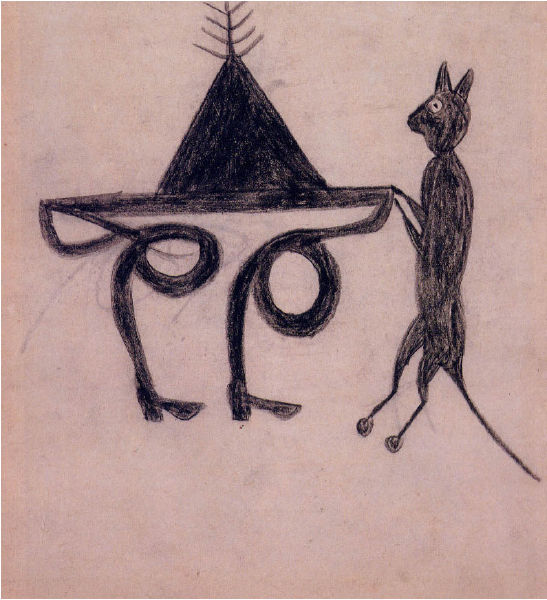 larger view |
Bill Traylor ( 1856 - 1949 ), "Man and Large Dog" Pencil and Gouache on Paper 1939 - 1942 Traylor was born into slavery on Alabama plantation and started drawing at age 85 in 1939. His spontaneous drawings provide a narrative of his life. From: Britton, Crystal A.. African American Art - The Long Struggle. Todtri Productions Limited: New York, New York. 1996, 35. Other works |
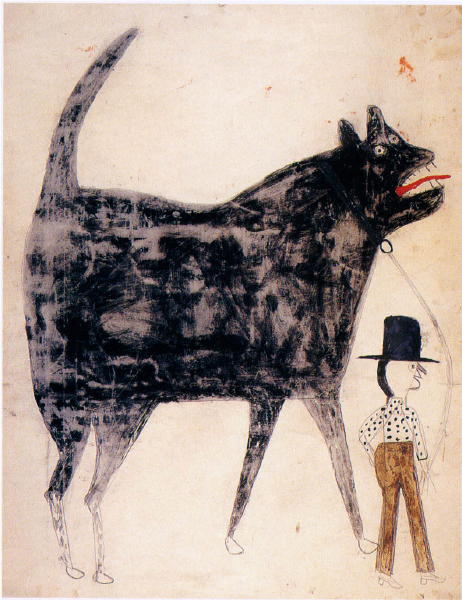 |
Charles Sallee Jr., "Girl with Pink Geranium" Oil on canvas 1940
Note: Harmon and Harriet Kelley have demanded that we not show images of any paintings they own. From: The Harmon and Harriet Kelley Collection of African American Art. The University of Texas Press: Texas, 1994, 49. |
William H. Johnson ( 1901 - 1970 ), "Going to Church" 1940 - 1941 Johnson was a Primitivist painter who painted several murals for the Harmon Foundation. He severed ties from the foundation in 1946, and was later found destitute in Oslo, Norway. He was helped by the director of the foundation, but never painted again. From: Patton, Sharon F. Oxford History of Art - African-American Art. Oxford University Press: New York, 1998, 153. Biography and more paintings at The North by South Website |
Source: The North by South See Also: Self Portrait with Pipe |
Pippin was a native of Pennsylvania and lived there most of his life. He fought in the 369th Infantry Regiment in World War I. A wound immobilized his right arm, but despite this fact he taught himself to paint. He burned images in wood with a hot poker, and then painted them with oils. This print is based on his mother's description of the scene. From: Patton, Sharon F. Oxford History of Art - African-American Art. Oxford University Press: New York, 1998, 134. Other works by Horace Pippin on view at AskArt |
Norman Lewis, "Harlem Courtyard" 1954 This is an example of Abstract Expressionism, a kind of "action painting" considered a uniquely American art form (173). It consisted of the spontaneous application of paint to canvas to show a particular moment. Lewis moved quickly to adopt the style. It was, for him, a way to communicate the content of a non-representational image to the public. The criss-cross lines evoke streets. From: Patton, Sharon F. Oxford History of Art - African-American Art. Oxford University Press : New York, 1998, 174. |
Norman Lewis, "Harlem Turns White" 1955 See above. From: Patton, Sharon F. Oxford History of Art - African-American Art. Oxford University Press : New York, 1998, 174. |
Hughie Lee-Smith (1914), "Reflection" Oil on Canvas 1957 Much of Lee-Smith's work shows a black figure set in a barren inner city. In his works the city was a metaphor for the isolation and apathy of the ghetto. From: Guy C. McElroy et al.. African - American Artists : 1880 - 1987. University of Washington Press : Seattle, Washington, 1989, 80. Discussion on a Rooftop (Howard U) |
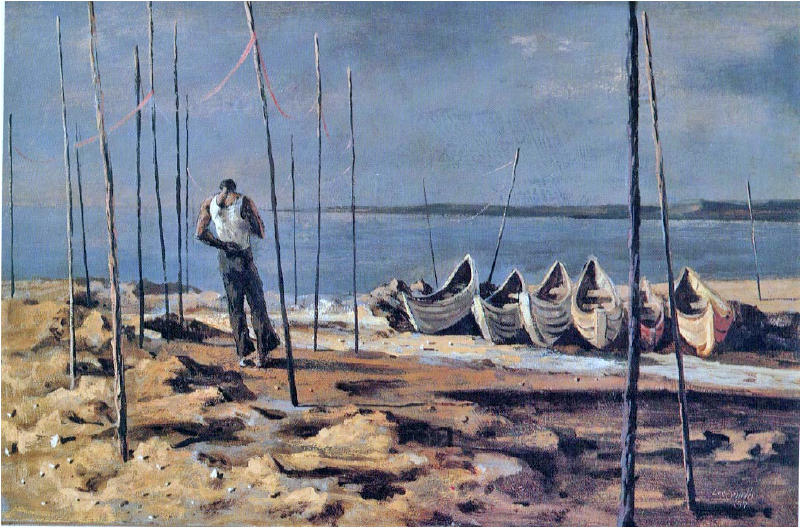 |
Elizabeth Catlett (1915), "Sharecropper" Woodcut 1970 Catlett attended the University of Iowa, where she exhibited her drawings. Much like Charles White, Catlett had an interest in the human figure, showing a sense of pride and dignity. She was primarily a sculptor but also made prints such as this one. From: Guy C. McElroy et al.. African - American Artists : 1880 - 1987. University of Washington Press: Seattle, Washington, 1989, 83. Other works |
Large view at the Art Institute of Chicago |
Romare Bearden (1912 - 1988), "The Magic Garden" Collage on board 1978 Born in Charlotte, North Carolina, Bearden moved to Harlem as a young child. He served in the army from 1942 to 1945 and traveled to Paris. Known for his revolutionary use of collage and photomontage, Beardon was a founding member of "Spiral," a group promoting civil rights in the visual arts. From: Barnwell, Andrea D. The Walter O. Evans Collection of African American Art. University of Washington Press: Seattle, Washington, 1999, 80. Other works |
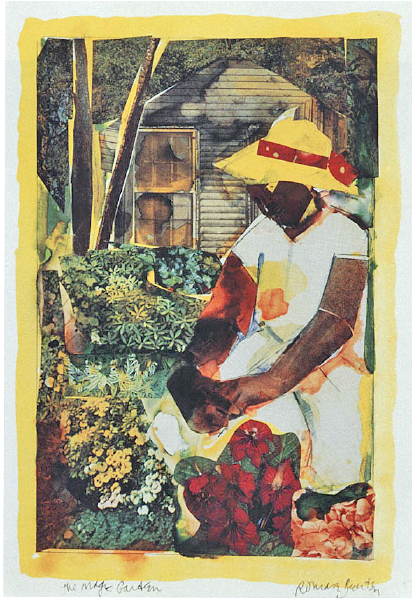 |
Melvin Edwards (1937), "Gate of Ogun" 1983 Ogun is the deity of iron and war found among the Yoruba, Bini, and
Fon people of West Africa. Ogun lives in the flames of the blacksmith's
forge, on the battlefield, and is felt in the cutting edge of iron.
The burnishing (the line-like strokes from polishing) gives the appearance
of brushstrokes. The gate is "a symbol of transition representing
the Middle Passage and spiritual transformation" (207). From: Patton, Sharon F. Oxford History of Art - African-American Art. Oxford University Press : New York, 1998, 206. |
Christian Walker, "Miscegenation" Photograph 1985 - 1988 One of 15 images in the series. Black and white figures intertwine with neither gender nor context obvious. It seems oddly titled--could the title be sardonic? From: Patton, Sharon F. Oxford History of Art - African-American Art. Oxford University Press: New York, 1998, 268. |
John Anansa Thomas Biggers (1924-2001), "Starry Crown" Acrylic on canvas 1987 "Starry Crown" is the name of a traditional spiritual, but it also refers to the headdresses of the women, "crowns of their cultural glory." Biggers traveled to Africa to study its culture and traditions, and also collected African American Art. From: Britton, Crystal A.. African American Art - The Long Struggle. Todtri Productions Limited : New York, New York. 1996, 91. Other works |
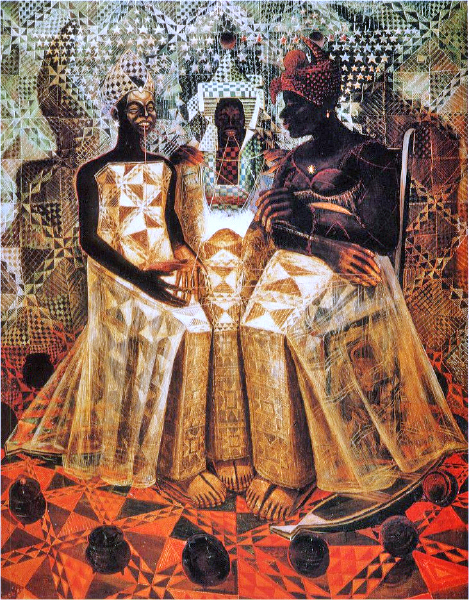 |
Faith Ringgold, "Change: Faith Ringgold's Over 100 lbs Weight Loss Performance Story Quilt," Fabric 1986 Thalia Goumand-Peterson describes a performance of "Change": During the performance Ringgold, dressed in a quilted jacket identical to the quilt reenacts her "Over 100 Pound Weight Loss" by reciting the text of the quilt. She emerges into the room dragging a big, black garbage bag (filled with two-litre plastic bottles of water) which looks like a human body and is equal to the amount of weight to the amount she lost, and she is hardly able to move. At various points through the performance she returns to the bag and tries to move it, but to no avail. Both at the beginning and the end, as Ringgold intones, "I can do it, I can change, I can change. Now", the audience is invited to join her in dance to the rhythms of "Only the Strong Survive". The finale is marked by the removal of the quilted jacket and Ringgold's emergence as she is now, as she has recreated herself as a Black activist, feminist, contemporary American artist whose art speaks with an authoritative female voice. (244) From: Patton, Sharon F. Oxford History of Art - African-American Art. Oxford University Press: New York, 1998, 245. |
Faith Ringgold ( 1930 ) "Subway Graffiti #3," Acrylic on canvas, Pieced fabric 1987 From: Cameron, Dan et al. Faith Ringgold's French Collection and Other Story Quilts - Dancing at the Louvre. University of California Press : Berkeley, California, 1998, 86. |
Faith Ringgold ( 1930 ) Sketch for "Dancing at the Louvre"Color Marker on paper 1990 Partial text from the quilt (see finished image for the rest): Dear Aunt Melissa, Marcia and her three little girls took me dancing at the Louvre. I thought I was taking them to see the Mona Lisa. You've never seen anything like this. Well, the French hadn't either. Never mind Leonardo da Vinci and Mona Lisa, Marcia and her three girls were the show. 2 They ran me ragged. Marcia wanted to go one way and the children another. The baby girl wanted to jump. The other two wanted to run, and did. Then they all just broke into a dance when we finally found the Mona Lisa. 3 Pierre used to say "Cherchez le fauteuil roulant, just get a wheelchair at the door of the Louvre, ‘cause if you don't you're gonna need one going home." I've been to the Louvre a hundred times, but never have I seen it like this. It was like looking at all the pictures upside down from a racing car going 100 kilometres a l'heure. (129) From: Cameron, Dan et al. Faith Ringgold's French Collection and Other Story Quilts - Dancing at the Louvre. University of California Press : Berkeley, California, 1998, 125. |
Faith Ringgold (1930 ) "Dancing at the Louvre," Acrylic on Canvas 1991 Partial text from quilt (continued from sketch): 4 Now that Marcia is married to Maurice, and they have moved to Paris, she and her children are determined to speak le bon Francais parfaitement by morning. I had to put her straight about me and the children. You know how it is with friends, they all want to tell you whom they think you are and how to live your life, and why. 5 Well I told her straight out, "Marcia, you know damn good and well your papa never went past the third grade." And that was good in those days, ‘cause he wasn't supposed to do that. But my papa was a school principal. He finished Lincoln Academy in Lynnsville. And I got the diploma to prove it. 6 Papa taught in Florida, South Carolina, and Georgia. I got all his licenses and test scores. Papa and Mama was both teachers. We didn't come up like no weeds. Not saying she did either. But I resent her telling me that my children belong in France. And that I should be raising them, not you. 7 Papa never allowed those Campbell boys in our yard. Chauncey, Buba, and Percy, none of Marcia's brothers was allowed in our yard. Now I'm not saying he was right ‘cause Papa, etait un snob. But I remember Papa, in that little pinstriped coat he used to wear and his glasses on the end of his nose. 8 Papa was something. "No, young man, you go out of this yard. The Simone girls are doing their chores and they have their studies, supper and to bed. Allez vous en!" then he'd hit that tail at the back of his coat like a period and turn at the same time. And those Campbell boys would fly out of our yard. 9 Papa wasn't too keen on Marcia either, but she always had a little way about her, like she thought she was tres chic. Marcia doesn't remember any thing about growing up poor in Atlanta. As far as she is concerned she was born in a first class cabin on the S.S. Liberte on her way to Paris, sipping Moet and smoking a Gauloise. 10 You should hear the story she told us about how she used to set the table for dinner with silver service and cristal every night ‘cause her father would get upset if he came home and the table wasn't formally set for supper. We were at a Paris party and her husband, Maurice, was present so I just "uh-uh'd" her. 11 But I remember the time we saw those Campbell boys coming out of Miss Baker's back door carrying food. They said they were cleaning out her ice box and the food was spoiled. Then Miss Baker came over crying to Papa that all the food in her ice box was gone. Papa sat Miss Baker down to our supper table and went straight over to Marcia's house. 12 And there was Mr. and Mrs. Campbell, and their three sons sitting at their kitchen table in the dark eating Miss Baker's food. When Papa came in they started coughing and gagging. They almost choked. But not Mademoiselle Marcia. Papa said she was on the back porch nursing un cristal de limonade and reading Madame Bovary. (129 - 130) From: Cameron, Dan et al. Faith Ringgold's French Collection and Other Story Quilts - Dancing at the Louvre. University of California Press : Berkeley, California, 1998, 93. |
||
This series of paintings was based on memories of Sunday sermons by Reverend Adam Clayton Powell Sr. Powell was a pivotal figure in the development of the Abyssian Baptist Church in Harlem and was responsible for raising money to move the Church to better quarters. Powell also opened a community center, home for the aged, and soup kitchens during the depression. The toolbox in the image symbolizes how the church, in the artist's mind, served as a building block for the community. This interest in showing the power of ordinary people shows that Lawrence is still serving the goals of the Harlem Renaissance (49). From : Barnwell, Andrea D. The Walter O. Evans Collection of African American Art. University of Washington Press : Seattle, Washington, 1999, 119. Other paintings |
Dawoud Bey ( 1953 ) "Brian and Paul" (Paul), Polaroid 1993 Large format Polaroid images ( 22 x 30 inch). Bey tends to photograph marginalized people to show their individuality and group identity. This is a photo of two men, but since the image is split in half, one is divided. From : Patton, Sharon F. Oxford History of Art - African-American Art. Oxford University Press : New York, 1998, 270. |
|
The African American Artist: An Historical Perspective by Thurlow Evans-Tibbs
African-American Artists, 1929-1945 - Metropolitan Museum of Art
Selections from American Art from the Howard University Collection
Minority-American Artists (Rhonda Willers)